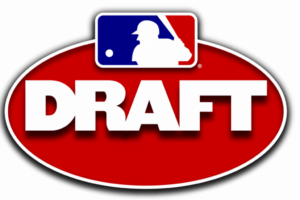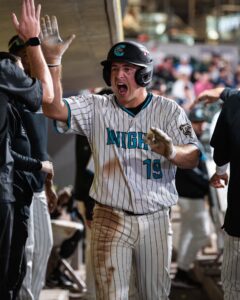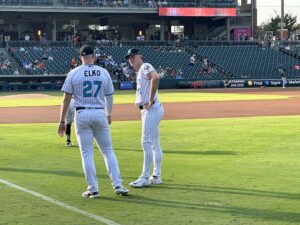The Glass Ceiling Prospect – Mason Robbins
One of the most challenging and fun things a prospect analyst can do, is “find” a diamond in the rough. Those few players who don’t have the draft or signing pedigree, statistical performance or hype surrounding them, but whom have some real major league potential. It is a pursuit which, even for the best in the business, will more often than not end in disappointment. But we try anyway.
For me, in order to spot these prospects who might later come from “out of nowhere”, I ask three questions…
- What is a player not doing that is key for future success?
- How fixable is that problem, for that player?
- What other tools or skills do they possess that will play up if the key problem can actually be fixed?
I call these glass ceiling prospects. They aren’t buried by physical limitations, which are more concrete. I can see where they are, and the path up to escape. Sometimes so can they, although often, years of dust have collected on that thin glass and obscured the view. It’s a thin layer that might seem like an increasingly impenetrable barrier the longer they stay beneath it. The Windex in this analogy is that amorphous quality in a player they call “make-up”.
Looking around the current White Sox system, a few players look like they might fit this mold. I’m going to focus on one in particular: outfielder Mason Robbins.
Let’s begin with what we see on the surface:
- 23-year old outfielder in High-A, in his 3rd pro season
- Drafted in the 25th round
- Relatively short, stout physical frame
- Has never hit for big power numbers – he has 7 home runs across over 200 games in both levels of A-ball
- Seems allergic to walks – his walk rate so far in 2016 is still under 3 percent
- Doesn’t steal bases or show other statistically expressed examples of speed
If you were doing a quick scan of players in system looking for players to further study, this is a guy you’d likely skip past. Heck even if you saw him in person, he might escape notice at first – no titanic blasts, nothing that jumps out physically, no gaze-across-the-bar-beautiful swing. But a little longer look, and you might be surprised what you find.
Going by tools, let’s start with speed. Robbins doesn’t really steal bases – he’s only attempted it four times this year. But if you have a stopwatch, and there’s a play where he’s running full bore, you’ll find he’s got real speed. Based on home to first and home to third times I’ve gotten, he’s at least 60 on the scouting scale, perhaps even a little higher. So that’s a plus tool that he can use on both sides of the ball.
Arm strength? Again, you have to be watching when it comes into play. When it does, he shows legitimately plus in strength and accuracy in my looks. There is some (admittedly flawed) statistical evidence to echo this – his 13 outfield assists so far in 84 games this year leads the Carolina League. That now makes two plus tools.
Glove work is even harder to evaluate in limited looks. He certainly has looked at least competent with the glove in the games I’ve observed, and talking with people who see him a little more often, the characterization was that he’s pretty good with it. Adding his speed increases his range as well. And he’s played both corners. So this sounds like an average skill set or better – adding another at least average tool, perhaps above average, with flexibility (he’s also played some first base).
This brings us to the hit and power tools, wherein lie both the problems and the opportunities. Take a look at some of the statistical oddities:
- Walk rate in 2016 is 2.6% (3.9% in July), and in 2015 it was 2.4%
- His contact rates: 15.6% K/PA in 2016, 15.5% K/PA in 2015
- His ISO is .128 so far in 2016, despite hitting just 5 long balls in a power-friendly home park
- He’s on pace for about 37 doubles and 8 triples in a typically full minor league season
His walk rate is among the lowest in the entire organization, if not the lowest among qualified players. Despite being no threat to walk, his contact rates are pretty decent. He’s below average in home run output despite playing half his games in a band box, but he’s on pace for well over 50 extra base hits. Using MLBFarm data, about 19% of his balls in play are line drives (which is a very solid number), and he’s got enough strength that his home runs spread nearly from foul pole to foul pole (as do his doubles and triples).
So what would cause these conflicting results? Watching him hit, you’ll find it’s a combination of physical and approach problems. But they are truly just one problem, expressed in two different ways (lack of game power, lack of walks).
Robbins ends up getting himself into the same physical trap on a regular basis – he sells out leverage for extension. He swings at too many pitches outside the zone, especially in 2-strike counts. He’s got such strong hands, and excellent barrel control, that he doesn’t strike out as often as he should when he does that. More than once I’ve seen him reach out (or down) for a pitch well out of the zone, and despite being bent over and too much on the front leg, he just flicks line drives into the gaps deep enough to make the wall. It’s not that he doesn’t recognize pitches – he just expands his zone (quite dramatically in deep counts) anyway.
If he continued this trend going up the ladder to higher levels of the minors, he’d eventually get eaten alive. But the thing is, when he does stay back and wait for his pitch, and puts his body in a position where his strong core really adds to his power, he can scald the baseball. Add in the barrel control, and here’s a hitter that could be a legit major league bat, with just one adjustment. Without the adjustment, his hit tool would likely grade out as a 30 or 35 for me. The power similarly suffers, and I’d put that at 40 FV.
I asked Mason about this in June – it’s a problem he’s aware of, and working to fix. I asked the question in a vague sort of way, and he immediately cited the source of the problem, so the awareness is there. And that’s the key – one adjustment, and more importantly, one that is eminently fixable. This isn’t a lack of bat speed, or inability to recognize pitch speed, or being too slow or unathletic. This is an adjustment he’s physically capable of making. He may or may not, which is the nature of all prospects, but the path in front of him is reasonably possible.
When he’s not lunged out over the plate? With everything else he brings? I’ve seen that version too, in games and BP. An FV of 50 on the hit tool is a reasonable ceiling. And a similar number on the power. That suddenly makes Mason a legitimate prospect, with approaching-average hit and power tools coupled with better-than-average speed and arm strength from the corners.
Robbins has been on fire in July, hitting .371 with 11 extra base hits (3 home runs) on the month, and his 5 walks are more than he had in April, May and June combined. So maybe he’s finally making those adjustments, staying back and waiting for the right pitch more often. If he is, and can keep it up, I’d confidently put Robbins somewhere in the teens among top prospects in the White Sox system. He’d be similar to a LHH Jason Coats, but with more speed and possibly a better arm. Not a future star, but a role player who could add value at the highest level.
Want to know right away when we publish a new article? Type your email address in the box and click the “create subscription” button. Our list is completely spam free, and you can opt out at any time.






